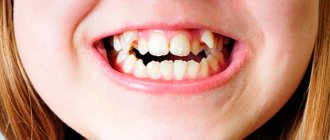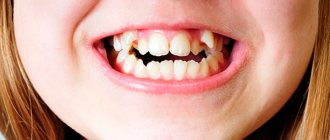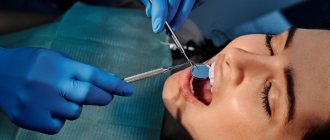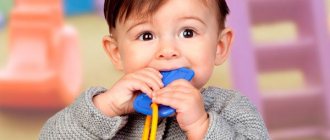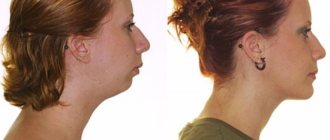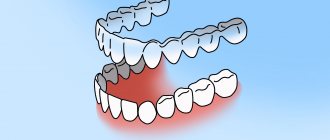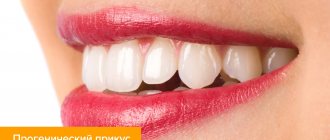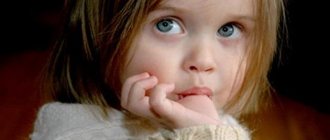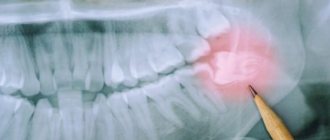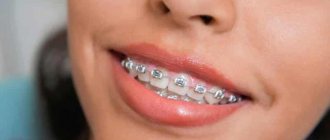23698
The formation of a person’s bite occurs in childhood before the eruption of all milk teeth.
This process is influenced by many factors - heredity, breathing problems, the position of the child during sleep.
According to most orthodontists, the use of a pacifier has the greatest impact on the development of the baby’s lower jaw and the correct growth of dental elements.
Not only the correct placement of the teeth in the jaw row, but also the further proportions of the face depend on the type and duration of its use.
Optimal age for use
Starting from the first days after birth, the baby begins to develop a sucking reflex. Innate instinct is vital for the further development of the child, as it ensures the receipt of milk from the mother's breast or bottle.
Another key purpose of the sucking reflex is to reduce motor activity of the brain and reduce the number of negative emotions.
Regular suckling of the mother's breast can reduce the baby's anxiety, promote his relaxation, and also reduce the risk of developing neurotic reactions in adulthood.
The intensity of the sucking reflex is different for each child, so in order to avoid disrupting the established diet, women often resort to using a pacifier.
The sucking instinct remains most pronounced in the first year of life. It is during this period that it performs a protective function in the baby’s body.
Using a pacifier at this stage of development allows you to achieve the following:
- distract the child from pain and discomfort;
- improve sleep;
- reduce excitability;
- eliminate the risk of tongue retraction during sleep;
- improve the bite of bottle-fed children with the correct selection of pacifiers.
Starting from 8-9 months of a baby’s life, his innate reflex gradually fades away, completely disappearing by 3-4 years.
This is due to the development of the child and the gradual transition to spoon feeding, which serves as an impetus for the development of the chewing instinct.
Therefore, most dentists and pediatricians recommend stopping further use of a pacifier during this period.
According to research, the process will bring a minimum of physiological and psychological inconvenience.
Reasons for the development of a crooked jaw and how to correct the defect.
Read here about the indications for compactosteotomy and the technique for performing it.
At this address https://orto-info.ru/zubocheliustnye-anomalii/zubov/polozheniya/etiologiya-razvitiya-i-metodyi-korrektsii-protruzii.html we will tell you what dental protrusion is and what causes it.
Vestibular plates
From the age of 4, the orthodontist can prescribe a vestibular plate, the use of which gives successful results and helps to cope with emerging anomalies. The vestibular plate can replace the child’s usual pacifier or pacifier. Vestibular plates can be with a visor - used for dentoalveolar protrusion of the upper dentition, or with a wire flap - used for an open bite with the tongue inserted between the teeth.
The use of a vestibular plate, selected by an orthodontist, helps restore the correct position of the tongue, as well as the functions of breathing, speech, chewing and biting, and can have a beneficial effect on the alignment of teeth and correction of the bite. Usually the plate needs to be worn at night and for several hours during the day.
Negative action
Despite the benefits of using a pacifier to satisfy a baby's sucking reflex, most dentists are unanimous in the opinion that long-term use of it has a negative impact on the condition of the oral cavity.
The size of the lower jaw of a newborn is significantly smaller compared to the upper. To enhance its growth, experts recommend focusing on breastfeeding, during which the lower jaw moves forward and the tongue makes wave-like movements.
When using a pacifier, the natural muscular balance is disrupted, resulting from the pressure of the tongue on the jaw line and the contraction of the muscles of the cheeks and lips during sucking.
The nipple puts pressure on the periodontium, leading to excessive stress on the mucous membrane. As a result, emerging teeth may shift into incorrect positions.
Most often, children who abuse a pacifier are subsequently diagnosed with a distal or open bite, as well as excessive forward inclination of the teeth of the upper jaw.
Pathological changes in the structure of the dentition occur if the total duration of pacifier use exceeds 6 hours a day.
If a child uses a soothing object extremely rarely, it will not cause malocclusion.
Now let's act like an adult
By the time of birth, the baby’s lips are well developed for active sucking activity, and the structures located deep in the oral cavity are practically not developed. Over time, the need for increased activity of the posterior parts of the tongue and more complex movements of the pharyngeal structures develops. The sucking reflex usually disappears and sequential maturation of oral functions occurs: from the anterior regions to the posterior ones.
The front-to-back principle of oral maturation is well illustrated by the process of speech development. The first sounds pronounced are the labiolabials “m”, “p”, “b”, so the first words of a newborn are usually associated with the pronunciation of these sounds (“mom” or “dad”). Some time later, consonants appear, pronounced with the tip of the tongue - “t”, “d”. The whistling sounds “ch” and “sch”, requiring the tip of the tongue to be placed close to the palate, appear even later. The sounds “k”, “g” and “r” require more precise positioning of the back of the tongue, so they may not be clear until 4-5 years of age.
As the baby grows, the activity of the muscles that raise the mandible during swallowing increases. As semi-liquid and almost solid foods are added to the child's diet, he is forced to use his tongue for more complex actions: to form a bolus of food, position it in the middle of the tongue and transfer it to the pharynx. Chewing movements of a small child usually involve a sideways movement of the lower jaw as it opens, then returns to the midline and closes to bring the teeth into contact with food. By 2–2.5 years, this method of infant chewing is already well developed. At the same time, with the help of more complex movements of the tongue in its posterior part, infantile swallowing turns into a more complex process.
The mature or adult swallowing pattern appears in some children as early as 3 years of age, but in most it is fully formed by 6 years of age and never develops in 10–15% of the population.
Additional product disadvantages
In addition to the development of an abnormal bite, frequent use of a pacifier, according to experts, can lead to the following problems:
- Deterioration of lactation. It may take a woman from two to eight weeks to fully establish breastfeeding.
You should stop using a pacifier during this period. In addition, experts note that when using a pacifier, the baby’s sucking reflex is satisfied without applying to the breast, which leads to a decrease in the woman’s milk supply and a switch to artificial feeding. - Impaired diction. Incorrect bite and tongue position in the oral cavity, resulting from frequent use of a pacifier, lead to problems with the pronunciation of many sounds when the baby begins to talk.
- Ear infections. As a result of sucking during nasal congestion, pressure increases in the area of the auditory tube. This often leads to infection and the development of otitis media and other ear diseases.
- Low sterility. If the pacifier falls out of the baby's mouth, it must be carefully handled to avoid the development of various intestinal infections. During the period when the child begins to roll over and crawl on his own, it is problematic to monitor this.
- The emergence of a habit. With prolonged use of a pacifier, a child develops dependence. Therefore, the older the baby, the more difficult it is for him to give up the habit.
About reflexes
The nutrition of a newborn, namely the receipt of milk and its entry into the gastrointestinal tract, is carried out through two actions: sucking and swallowing. How does this happen? The milk ducts of the mother's breasts are surrounded by soft muscles that contract to release milk. To obtain milk, the baby does not need to suck it from the mother's breast, but only needs to stimulate the soft muscles so that when they contract, they release milk. During feeding, the baby makes small squeezing movements with its lips, which are instinctive actions. Once the milk enters the baby's mouth, all he has to do is lower his tongue to allow the milk to flow further into the throat and esophagus. At this moment, the tongue moves forward until it touches the lower lip.
This sequence of actions determines infant swallowing, the so-called infantile type of swallowing, in which there is an active contraction of the muscles of the lips and the orbicularis oris muscle, the tip of the tongue moves forward to contact the lower lip and upward to press the nipple to the palate.
The contact of the tongue with the lower lip is so common in newborns that it is considered a resting position. You can often notice that if you lightly tug on a newborn's lip, the tip of the tongue moves along with the lip, as if it were glued to it.
Selection rules
To reduce the harm caused to the baby by regular use of a pacifier, it is necessary to choose this device correctly.
Preference should be given to special orthodontic nipples. These products differ from ordinary pacifiers in their anatomical shape, which is equipped with a beveled surface on one side and a convex surface on the other.
In this case, the beveled part of the product must be placed on the side of the child’s tongue, and the convex part in the area of the palate.
Thanks to this design of the pacifier, the growth of the lower jaw is activated, which from the birth of the child significantly lags behind the upper jaw in size.
In addition, the pressure exerted on the palate and upper jaw is insignificant, which contributes to their full development.
When choosing, you must also pay attention to the following points:
- Material of manufacture. There are two types of nipples on sale: silicone and latex. Silicone products are more durable and can withstand high temperatures, making them easier to boil.
At the same time, they have little elasticity, so after teething, there is a possibility that the child will chew them.Pacifiers made from latex are more durable, however, they cannot withstand high temperatures and also quickly accumulate bacteria on the surface, so they will have to be changed more often. In addition, latex products can cause an allergic reaction.
- Size. Depending on the age of the child, the size of the pacifier changes. So, for babies up to 6 months, a size 1 pacifier is suitable. Children older than six months should use size 2.
- The presence of an air valve. This indicator is important when choosing a bottle nipple for feeding. The presence of a valve reduces the likelihood of the baby swallowing air, as well as the pacifier sticking together.
Methods of treating crowded teeth and the consequences of lack of therapy.
In this article we will discuss the problem of a small lower jaw in an adult.
Follow the link https://orto-info.ru/zubocheliustnye-anomalii/ryadov/zuboalveolyarnogo-ukorocheniya.html to learn more about dentoalveolar shortening in the molar area.
Observation by an orthodontist during primary occlusion
Anomalies of the “milk” period have a negative impact on the formation of a removable and then permanent bite. If the problem is not eliminated at this age, the formation of a permanent bite will occur with disturbances, which will entail more serious orthodontic treatment. Progressive abnormalities that affect the growth and development of the jaws must be treated as early as possible. Timely orthodontic treatment, begun during the period of primary occlusion, normalizes further jaw growth and helps correct the occlusion.
How to wean off painlessly
The process of weaning a child off a pacifier is very individual. Some children do not notice the disappearance of the rubber device from their lives, being distracted by new activities. Others, on the contrary, experience severe stress.
Many mothers, based on their own experience, note that the process is most comfortable when the baby is between 6 and 10 months old.
To make the process as comfortable as possible, you must adhere to the following recommendations:
- choose a teether when the child’s first tooth grows - this will help distract attention from the usual pacifier and speed up the teething process;
- stop using a pacifier to soothe the child - pick him up, talk to him, rock him to sleep;
- reduce the frequency of use when getting ready for bed, replacing it with a relaxing massage, reading a fairy tale, singing a lullaby;
- Remove the pacifier from the baby's mouth after he falls asleep.
If it is necessary to wean a child older than one year from a pacifier, experienced parents advise resorting to some tricks.
For example, exchange a pacifier for an interesting toy, lose it, or offer to give it to a younger friend.
The complexity of the process of weaning a child from a pacifier may depend not only on the degree of dependence of the child, but also on his physical and emotional state at a certain point in time.
Therefore, if the baby is sick or in other stressful situations, it is better to postpone giving up the pacifier to a more favorable moment.
Child oral care
You can soften the effect of the pacifier on the baby's palate and jaws not only by using anatomical models, but also by using special oral care products. ASEPTA Baby products are rightfully considered one of the best children's dental products:
- ASEPTA Baby wet wipes from 0 to 3 years (special finger pads are designed for gentle cleansing and massage of the baby’s oral cavity).
- ASEPTA Baby gel toothpaste from 0 to 3 years (effective prevention of inflammatory processes in the oral cavity and prevention of the development of caries in children).
- ASEPTA Kids gel toothpaste from 4 to 8 years (prevention of caries, inflammatory processes and tartar formation).
- Paste for permanent teeth ASEPTA Teens from 8 years (saturation of tooth enamel with minerals, prevention of caries and prevention of gum inflammation).
Thanks to the wide range of tastes and aromas of ASEPTA products, the child will be happy to brush his teeth on his own. The natural composition of the pastes, as well as beneficial plant extracts and calcium enrichment, makes the series an indispensable oral care product for children. ASEPTA cares about the health of children's teeth!
Sources:
- Study of the clinical effectiveness of the use of therapeutic and prophylactic agents of the ASEPTA series in the treatment of inflammatory periodontal diseases in children and adolescents (I.V. Klimova) Irina Vladimirovna Klimova, Candidate of Medical Sciences, Associate Professor of the Department of Pediatric Dentistry, Novosibirsk State Medical University. Department of Pediatric Dentistry, Novosibirsk State Medical University.
- The use of adhesive balm "Asepta®" in the treatment of inflammatory periodontal diseases L.Yu. OREKHOVA*, Dr. med. Sciences, Professor, Head of Department V.V. CHPP**, Dr. med. Sciences, Professor, Head of Department S.B. ULITOVSKY*, Dr. med. Sciences, Professor A.A. LEONTIEV*, dentist A.A. DOMORAD**, O.M. YAKOVLEV** SPbSMU named after. acad. I.P. Pavlova, St. Petersburg - *Department of Therapeutic Dentistry, **Department of Microbiology
- Clinical experience in using the Asepta series of products Fuchs Elena Ivanovna Assistant of the Department of Therapeutic and Pediatric Dentistry State Budgetary Educational Institution of Higher Professional Education Ryazan State Medical University named after Academician I.P. Pavlova of the Ministry of Health and Social Development of the Russian Federation (GBOU VPO RyazSMU Ministry of Health and Social Development of Russia)
Other influencing factors
Some parents are perplexed why, if they rarely use a pacifier or completely abandon it, the child’s bite is not formed correctly enough.
It is worth understanding that in addition to the nipple, this process is influenced by many other factors:
- incorrect head position during sleep;
- timing of teething;
- mouth breathing;
- genetic predisposition;
- posture.
To avoid the formation of malocclusion, the child’s oral cavity should be examined regularly by a dentist.
Therefore, consultation should be sought every 3-4 months from the eruption of eight baby teeth.
After the development of the primary occlusion is complete, at 2-3 years of age, visits to the dentist should occur once every six months.
In the video, Dr. Komarovsky talks about how the pacifier affects a child’s bite.
Early loss of baby teeth
As mentioned above, untimely loss of baby teeth can negatively affect the formation of a correct bite. Baby teeth prepare space for permanent teeth, which ensures straight teeth in older age. With the early loss of primary teeth, permanent teeth may not erupt correctly, there may be a lack of space between the molars and canines, permanent molars may move into place of the removed primary teeth, which may lead to the need for their removal in the future when permanent teeth begin to emerge. To prevent these phenomena from occurring, special devices are used - replacement devices - to help maintain space in the dentition. If several baby teeth are lost, then a removable plate is used, if one tooth is lost, then a non-removable orthodontic device is used.
If the front teeth are lost (as a result of caries or injury), then a prosthetic plate is used. Using this device, you can restore chewing function and speech, protect the periodontium from overload, preserve space for permanent teeth and prevent the displacement of remaining teeth.
NEW LEVEL
The expectant mother, along with the “children’s dowry,” usually receives a pacifier as a gift, often more than one. The pacifier in the popular consciousness is strongly associated with the image of a baby; Parenting magazines are filled with advertisements for pacifiers, where the question of their necessity is not questioned at all, the mother is only asked to choose between different “orthodontic” forms and striking designs. Unfortunately, some child health specialists also consider it their duty to advise a new mother to “get a good pacifier to make it better for everyone.” However, when lactation consultants see a baby with a pacifier, they mentally raise a red flag...
Why, where many experts assure: “No harm done!”, are lactation consultants wary? There are a number of very serious reasons for this, supported by many scientific studies that are being conducted around the world, and consulting practice: after all, it is consultants who have to deal with the visible negative consequences of using pacifiers, and not, for example, a nurse in a maternity hospital. All this will be discussed in the article, so that a mother who is thinking about whether to give her child a pacifier does not simply rely on someone’s opinion “this is good” or “this is bad,” but on specific data about the risks.
Pacifier shortens breastfeeding
Theoretically, this is quite logical and understandable: milk production depends on how correctly, well and often the baby sucks at the mother’s breast. Precisely the mother's breast, and not anything else. If the baby is supposed to suckle at the mother's breast, but he sucks the pacifier, this will quickly lead to a decrease in milk production due to decreased stimulation of the breast. And then the nipple and breast can begin to smoothly “change roles”: in some cases, it will seem easier for the mother to give a pacifier, and the baby will prefer the pacifier - and the mother will wonder why she has less milk. Although, perhaps, it won’t even happen if the relatives who initially gave the pacifier later say that “we just have a non-dairy breed”...
This is why it turns out in dozens of studies around the world that where a pacifier is present, breastfeeding ends much earlier than it could have continued without the pacifier. In its “Ten Steps to Successful Breastfeeding,” the WHO formulated the ninth step as “ do not give artificial breast substitutes and pacifiers to breastfed children ” (English original, Russian version on the WHO website and in the National Guidelines for Neonatology 2009) For many, it is not obvious : WHO makes its recommendations for a reason, but only based on reliable scientific research data, and any recommendation has a scientific basis. In particular, you can find out why WHO suggests not giving infants a pacifier in chapter nine of the voluminous document Evidence for the ten steps to successful breastfeeding." Unfortunately, in Russia such studies are practically not conducted - this is not a topic that interests our research medicine , and the bulk of the data comes from abroad. You can get acquainted with some of them under the spoiler; If you're not interested in scientific evidence, just read on.
There have been a lot of studies on how the use of a pacifier affects breastfeeding and there will probably be more; but the main thing is that they give very similar results. Here is a selection of the most revealing ones (in fact, this is only a small part of the available data, which, alas, few people in Russia are familiar with...)
Evidence
| authors (link active) | a country | sample | result |
| Victora CG et al 1993 | Brazil | 249 children who were on breastfeeding at the age of 1 month | The risk of a baby being weaned at any age from 1 to 24 months is 3 times higher for those who suckled a pacifier per month than for those who did not suckle |
| Barros FC et al 1995 | Spain | 605 children born in one maternity hospital in January and February 1993. | The relative risk of weaning between 1 and 6 months of age, after adjusting for confounders, was 2.87 times greater in those who received a pacifier at 1 month of age compared with those who did not. |
| Victora CG et al 1997 | Brazil | 450 children | Children who actively sucked a pacifier at the age of 1 month were 2.5 times more likely to stop breastfeeding by 6 months |
| Righard L, Alade MO, 1997 | Sweden | 82 mother-child pairs on exclusive breastfeeding on the 5th day after birth | At 4 months, 91% of those who did not receive a pacifier and 44% of those who were given a pacifier remained on breastfeeding. The study cited “nipple confusion” as the reason for early termination of breastfeeding. |
| Vogel AM et al 2001 | New Zealand | 350 mother-child pairs aged 1 year | When using a pacifier daily, the risk of early termination of breastfeeding is 1.7 times higher than without a pacifier or using it rarely (not every day) |
| Levy SM et al 2002 | USA | 1,387 babies in Iowa | Pacifier sucking, especially when combined with thumb sucking, is significantly associated with early breastfeeding cessation |
| Mikiel-Kostyra K et al 2005 | Poland | two consecutive surveys: the first with 11,422 newborns, the second with 10,156 infants under six months | Risk factors for exclusive breastfeeding were elucidated. It turned out that while in the maternity hospital, exclusive breastfeeding is most interfered with, in order of importance: caesarean section, starting breastfeeding later than 2 hours after birth, lack of skin-to-skin contact, pacifier, separation from the mother and health problems in the baby. After returning home, the main factors due to which exclusive breastfeeding did not take place were: the use of a pacifier, the mother’s reluctance to feed for longer than 4 months, and the low level of parental education. |
| Scott JA et al 2006 | Scotland | 586 women who were interviewed by telephone several times before their children were one year old | By one year, only 19.2% of children were still breastfed. Duration of breastfeeding was negatively associated with difficulty breastfeeding in the first 4 weeks, maternal smoking, pacifier use, and early return to work. |
| Karabulut E et al 2009 | meta-analysis (different countries!) | 31 studies on the effect of pacifiers on breastfeeding | The risk of stopping breastfeeding before 6 months for children who use a pacifier is 2 times higher than for those who do not; a pacifier shortens the duration of both exclusive breastfeeding and breastfeeding in general. |
| Feldens CA et al 2012 | Brazil | survey of 360 participants, 210 of whom stopped breastfeeding before a year | Postpartum depression, bottle feeding and pacifier use were associated. The likelihood of stopping breastfeeding before one year of age is higher in children whose mothers had moderate to severe symptoms of depression and were bottle-fed or given a pacifier in the first month of life. |
| Bertino E et al 2012 | Italy | 562 mother-child pairs, telephone survey several times before the children were one year old | At 6 months, 8.9% of children were on exclusive breastfeeding, 44.3% stopped breastfeeding. 25.3% of children receive breast milk per year. The main factors for stopping breastfeeding are maternal smoking, the use of a pacifier, and the mother's attitude towards breastfeeding. |
| Salustiano LP et al 2012 | Brazil | 667 children aged about 6 months | The most significant factors for stopping breastfeeding before 6 months are the use of a pacifier and maternal employment outside the home. |
| Gerd AT et al 2012 | Sweden | all children born in 2007-2008 in southwest Sweden | The goal is to find out the factors associated with stopping breastfeeding before reaching 1 month. The most significant factor is pacifier use, followed by maternal smoking and breastfeeding problems. |
| Martins EJ, Giugliani ER. 2012 | Brazil | 151 mother-child pairs | The purpose of the study is to find out which women breastfeed children up to 2 years of age and longer. As it turned out, these are mothers who stay with the child until at least six months, do not use pacifiers and do not give children any additional liquids until six months. |
| ZMS, SJ, J KN, MNB, A T. 2013 | Malaysia | 2006 national survey | One part of the study is to find out how breastfeeding and pacifier sucking relate. The average duration of breastfeeding in children with a pacifier was 11 weeks, without a pacifier - 18 weeks. A third of all children who sucked a pacifier were left without breastfeeding before 6 months of life. Pacifier use was significantly associated with reductions in both exclusive breastfeeding and general breastfeeding. |
| Nickel NC, Labbok MH et al 2013 | USA | results of a large national study, Infant Feeding Practices Study II | The goal is to find out how non-compliance with all Ten Steps to successful breastfeeding affects the duration of breastfeeding. Ignoring step 6 (not giving breast milk substitutes) resulted in a reduction in breastfeeding time by an average of 10.5 weeks. The largest reduction in breastfeeding time (an average of 11.8 weeks) was caused by the combination of missing two steps - Step 4 (start breastfeeding in the first hour after birth) and Step 9 (do not use pacifiers). |
| Alves AL, Oliveira MI, Moraes JR. 2013 | Brazil | cross-sectional study: 589 children under six months in 2003 and 707 in 2006 | The duration of exclusive breastfeeding is reduced by the following factors: caesarean section - by 16%; low level of maternal education - by 20%; use of pacifiers - by 41% . |
| Rius JM et al 2014 | Spain | 452 mother-child pairs | When determining the factors for early cessation of breastfeeding, the most influential were, in order of importance: pregnancy by IVF; use of silicone nipple covers; low maternal expectations regarding the timing of breastfeeding; maternal smoking; regular use of a pacifier in the first month of life and some other, less significant ones. |
I will take away from the spoiler only one study conducted by meticulous Australian scientists (Mauch CE et al 2012), who wanted to find out everything about why, when and with what consequences nursing mothers give pacifiers to their first children. Of the 670 mothers in the study, 79% gave a pacifier, with one in four doing so at the insistence of the child's grandmother, and one in five at the recommendation of a nurse or midwife. The majority of women believed the arguments that this would help the baby sleep better and make him more calm; every fifth person believed that sucking a pacifier was natural and necessary for a child. The result was that most women who began regularly giving their baby a pacifier in the first weeks of life ended their breastfeeding before the baby was one month old . Here is a visual picture showing how, according to the study, the duration of breastfeeding depended on the use of a pacifier (the horizontal axis is the duration of feeding in weeks, the bottom line of the graph is those who started giving a pacifier in the first month of life; the middle line is those who offered a pacifier only after when the child is one month old; and the top one - those who have never given a pacifier to their child).
What can you say - a big “thank you” for prematurely ending breastfeeding to those health workers who convince mothers to give their baby a pacifier, because it is healthy, safe and will not affect breastfeeding in any way!..
The pacifier spoils the attachment to the breast and contributes to nipple injuries
This is precisely one of the reasons why some mothers stop feeding much earlier than expected. With proper sucking, the baby extracts milk by creating a vacuum and at the same time actively working with the lower jaw. In order to take the mother’s breast well, the baby needs to open his mouth wide, and when applied correctly, the nipple ends up deep inside, far from the moving parts of the mouth (the lower jaw and the tip of the tongue). And to give a baby a pacifier, you don’t need to open your mouth wide at all. If an adult wishes, the pacifier can even be put into the child’s closed mouth. When sucking a pacifier, other muscle groups work to a greater extent, and their coordination occurs in different ways. Often, just by the way the baby prepares to eat, it is clear whether he is feeding from the breast or through a pacifier: the baby opens his mouth wide so that the mother’s breast fits comfortably into it, and the “artificial baby” stretches his lips with a tube towards the pacifier. If a pacifier is given to a baby who has not yet learned how to interact with his mother's breast, he may try to suck on his mother's breast in the same way as a bottle pacifier or pacifier, this phenomenon is known as "nipple confusion." In this case, the baby will either not receive milk at all, or will receive very little (hence the complaints “my baby hangs on my chest for hours, but calms down only after he gets a bottle”).
Another unpleasant effect of using a pacifier: it is an inanimate object that cannot react in any way to its “torment.” A baby, especially during teething, may enjoy biting and chewing on a pacifier. He will try to do the same with his mother’s breasts when feeding, because for him both are objects of sucking. And his mother’s dissatisfaction will be completely incomprehensible to him, serving as another reason to choose a more predictable and “reliable” subject...
A clear illustration of this problem: according to a survey conducted in the LiveJournal communities lyalechka and malyshi, where 580 mothers took part, the use of a pacifier correlated with nipple pain in the first days of feeding:
(source: https://meridian-30.livejournal.com/119922.html)
Pacifier leads to breast refusal
Interacting with a mother's breast is more difficult than interacting with a pacifier. Not “more difficult”, but more complex and varied. Milk flows from the mother’s breast at different speeds - at high tide, the streams can literally splash into the baby’s mouth, and sometimes you have to work to get “hind” milk, which is rich in fats, but also leaves the breast more slowly. A baby who receives only his mother’s breast gets used to its characteristics after a while and knows, for example, that if he works on a seemingly empty breast, milk will soon begin to flow. And if the child is accustomed to a constant flow from a bottle nipple or to falling asleep with a pacifier, from which nothing flows at all, the “behavior” of the mother’s breast, unpredictable in comparison with the constancy of the nipple, makes the baby nervous. Therefore, it happens that the baby breaks away from the mother’s breast (where there is milk), and, to the mother’s bewilderment, begins to cry. Having received the pacifier, he calms down.
The other side of the same problem is that the mother’s breast performs two important functions in the baby’s life: satiation and calming. Both functions are equally important, because a small child enjoys not only delicious milk, but also the sucking process itself. Very often, a baby who has experience breastfeeding actively refuses his mother’s attempts to “provide a rubber replacement” by spitting out the pacifier. But if mom insists, the baby will have no choice but to agree. And after some time, the child will learn the lesson “it makes sense to suckle only to get milk” so well that he will begin to turn away from the breast when the flow of milk dries up. Just at the age of about 3-4 months of the baby’s life, many mothers stop feeling the flow of milk, or the milk does not begin to flow immediately, but only after the baby makes several sucking movements. But where a baby who does not know the pacifier will suck diligently, knowing that the milk now does not come immediately, a child accustomed to a pacifier refuses to suck without a rush - he abandons the breast. After all, from his point of view, you just need to suck on a rubber plug, and mother’s breast, from which streams of milk no longer immediately flow, is not suitable for “idle sucking”!..
Of course, there are always families where babies receive a pacifier and at the same time continue to safely feed on their mother’s breasts, avoiding all the problems already listed. Even if we look at the graphs above, we will see that there are a number of infants with a pacifier where “everything is fine.” But no one can predict in advance how a pacifier will turn out for a particular child, whether breastfeeding will continue or end, with the active help of a “cunning friend.” Moreover, the probability of losing breastfeeding, as we remember, is several times higher than maintaining it. And even if it persists, other complications for the child’s health are associated with the pacifier...
The pacifier spoils the bite
Incorrect sucking, which develops in a child as a result of using a pacifier, has a very long-term impact: experts who have deeply delved into this topic talk about problems not only during breastfeeding, but throughout their entire life. Movements practiced in infancy are retained forever, and the habit of sucking a pacifier makes itself felt in an adult. This happens due to the fact that the principle of sucking a breast and a rubber nipple is fundamentally different. And this does not depend on the appearance of the nipple, as pacifiers and breast-shaped bottles try to convince us, but, first of all, on the quality of what ends up in the child’s mouth. Mom's breasts are very soft and, when they enter the baby's mouth, they adapt to his shape. An artificial nipple, on the contrary, is relatively non-plastic, so the child’s oral cavity has to adapt to the foreign object introduced into it.
At a time when the oral apparatus of a newly born baby is actively growing and developing, any object other than the breast negatively affects the formation of the jaw, teeth, and the shape of the palate. The pacifier creates pressure in the mouth that is not intended by nature, which leads to tooth movement. Dr. John R. Neil, an Australian researcher, discovered that babies' tongues work differently when they suck on a breast or a pacifier. Infants made peristaltic (wave-like) movements with their tongue, which helped the milk extracted from the breast move to the pharynx. And the children who were given a pacifier made pushing movements of the tongue (the tongue moves like a piston). The results of the study showed that all infants who had never received a pacifier sucked at the breast with a physiological, wave-like movement of the tongue. Among those who sucked a pacifier together with the breast, 13 children had piston-like movements of the tongue, and 18 had wave-like movements of the tongue. Finally, it turned out that all children, without exception, whose tongue moved like a piston, received a pacifier.
All this leads to improper functioning of the stomatognathic system (including the pharynx, dentition and oral cavity). A recent study by Brazilian scientists Silveira LM et al 2013, after studying the oral skills of 125 babies aged 9 months, concluded that breastfeeding has a positive effect on the functioning of the stomatognathic system, but sucking a pacifier, on the contrary, inhibits sucking and chewing skills and is associated with poor development of the corresponding muscles. But quite the opposite belief is often encountered!..
Brian Palmer, DDS, a renowned expert on the effects of breastfeeding on children's health, has spent nearly thirty years researching oral deformities. All these years, he defended the point of view that a child's sucking of a pacifier or bottle nipple is a critical factor for disorders in the development of the maxillofacial apparatus. You can view some of Dr. Palmer's presentations, translated into Russian, on the La Leche League Russia website. If you understand English text well, you can immediately go to Dr. Palmer’s website. Find the results of the latest dental studies showing the effect of pacifiers on bite formation under the spoiler.
Some data on the effect of pacifiers on bite
| authors (link active) | a country | sample | result |
| Montaldo L et al 2011 | Italy | survey of parents of 1451 children aged 7 to 11 years | Non-nutritive sucking habits (such as pacifier) have been associated with malocclusions, anterior open bites, and abnormal molar growth |
| Romero CC et al 2011 | Brazil | 1377 children from 3 to 6 years old | Children who had never been breastfed had a 7 times greater risk of having an anterior open bite than those who had been breastfed for more than 12 months, and more than 9 times more likely than those who had been breastfed for more than a year and I didn't suck on a pacifier. Each year of sucking on a pacifier increases the risk of developing malocclusion by 2.38 times. |
| Franco Varas V, Gorritxo Gil B. 2012 | Spain | 225 children from 2 to 10 years old | Using a pacifier significantly worsens the bite in children. Moreover, if the habit of sucking a pacifier was abandoned early, then the damaged anterior bite can still be corrected, but problems with the posterior bite remain forever. |
| Bueno SB et al 2013 | Brazil | 138 children aged 4 to 5 years | The use of a pacifier is the most harmful factor for the formation of a malocclusion, which increases the likelihood of the formation of an anterior open bite by 3.33 times, and the likelihood of a malformed posterior bite by 5.26 times. |
Using a pacifier increases the risk of infections
So, the movement of the tongue during swallowing is critical for the normal development of the mouth, airways, facial shape, proper bite and tooth alignment. In particular - this is just one of the details! – a pattern was tracked due to which “artificial babies” are four times more likely than infants to suffer from otitis media: the pressure of the nipple on the area near the border of the hard and soft palate leads to improper development and functioning of the eustachian tube apparatus. First of all, this applies to situations when a child eats from a bottle with a nipple; but infants who receive “just” a pacifier are noticeably more likely to suffer from attacks of acute otitis media (Salah M et al 2013 and other data below).
In addition to the incorrect formation of the maxillofacial apparatus due to pressure on the palate unforeseen by nature, various pathogenic organisms multiply very well on the nipples. Thus, a study by DJ Manning et al 1985 showed that 44% of laboratory-studied baby pacifiers were contaminated with candida fungus, which is the cause of thrush. This was confirmed by data from Sio et al, 1987 - in babies who sucked a pacifier, thrush in the mouth was twice as common as in those whose parents did not give a pacifier.
More Science on Pacifier-Related Infections
A study by Niemela, Uhari & Mottonen, 1995 found that children who sucked a pacifier between the ages of one and three years were 25% more likely to have an attack of acute otitis media. No associations with otitis media were found for breastfeeding.
The study Jackson JM, Mourino AP 1999 consisted of 200 children under the age of one year. The risk of developing otitis media was twice as high in children who sucked a pacifier, and five times higher if the child was bottle-fed or attended a nursery.
A study by Niemela M, Pihakari O, Pokka T, Uhari M. 2000 found that if parents of babies from 7 to 18 months were warned about the dangers of using pacifiers (medical staff talked about this in detail, with the issuance of special leaflets) and parents reduced the use of pacifiers, then the number cases of otitis decreased by 29% compared to the control group. If children did not suck a pacifier at all, then there were 33% fewer cases of otitis media.
An Italian group of scientists, Festini F et al 2012, looked at two groups of babies from one to three years old: 63 children who had at least one episode of diarrhea or enteral infection in the first year of life, and 78 without such episodes. In the first group, 61.9% of children began receiving a pacifier in the first month of life, and more than half as many - 29.4% - in the second.
A pacifier can cause injury
Most mothers don’t think about this at all. Until it affects someone... And various injuries due to the use of a pacifier are not so rare.
A mucocele is a cyst of the oral mucosa, a benign formation, which, however, may require removal by a surgeon or dentist. A study by Alves LA et al 2010 states that in children, mucocele of the lower lip often occurs due to inadequate pacifier use.
There are also “just injuries.” For example, in 2012, the United States conducted a retrospective analysis of all cases in which children were admitted to surgery due to the use of bottles, pacifiers and sippy cups over a 20-year period (from 1991 to 2010 inclusive). It turned out that during this time, 45,398 children under three years of age were treated for such injuries, on average in the USA alone more than 2,200 cases annually (who would have thought, right?..) Most of the problems are associated with the use of bottles (65.8%), Next came dummies (one in five of these injuries). One-year-old children were most often affected; the most common injury was a ruptured mouth caused by a child falling with a bottle or pacifier in the mouth. Details are in the study by Keim SA et al 2012.
Objections to restrictions on pacifiers...
But how can you go for a walk without a pacifier? The child swallows cold air into his open mouth... Most babies do not walk with their mouths open. A child’s mouth may be open during a walk for several reasons:
- if he has a stuffy nose and it’s hard for him to breathe through his mouth - but is it necessary to take a child with a stuffy nose, that is, who has a cold, into the cold air?..
- if the baby fell asleep in the stroller so that his head was thrown back, in this case it is enough to place a pillow or something else so that the head moves from the thrown back position to its normal position;
- if the child cries - in this case, crying serves as a signal of the child’s stress; It is advisable to try to eliminate this stress, instead of just giving a pacifier. Stress can be associated, for example, with walking too long (many mothers walk for hours at a time because they have been told that it is good for the child’s health to walk for so many hours every day - but what will be the benefit if the child is nervous to the point of crying?! ); or because the baby doesn’t want to be in a stroller, but closer to his mother, and then it’s better to try walking with the baby in your arms or in a sling instead of a stroller.
There are hundreds of thousands of mothers in the world who have never given their children a pacifier, and this does not stop them from walking on the street. A pacifier is simply not a necessary item either on the street or in a child’s trousseau in general - unless the mother plans long absences, such as going to work or school, when it is impossible to avoid long periods of the baby being without the mother.
The mother should not allow the child to use herself as a pacifier. Still, active advertising of artificial feeding has a very strong influence on society, nursing mothers and their ideas about what is normal and what is not. “Using a mother instead of a pacifier” implies that bottle feeding is normal for the speaker, and breastfeeding is not perceived as a normal situation. Imagine someone telling you: “You shouldn’t let your husband use you instead of a rubber woman!” You will probably be shocked by the very formulation of the question, when someone, in principle, considers it normal to give preference to a rubber woman with a living wife; but when mothers are reproached for allowing their child to “use themselves instead of a pacifier,” the point is that giving a child a pacifier seems to be normal, but communicating with a warm, lively, beloved mother is not!..
If a child has a strong need to suck, then it is impossible to do without a pacifier: the mother simply will not have any life left, she will be forced to feed endlessly. Indeed, different babies have different sucking needs. And there are some babies who seem ready to suckle endlessly. They suck, spit up, grab the breast again... And very often in this situation the mother is advised: give her a pacifier, because you can’t feed around the clock. But this is the wrong path!.. If a child strives to suck all the time, and this desire is not satisfied with mother’s milk, it means that the child is worried about something, in addition to ordinary hunger. And we need to look for and eliminate the cause of this anxiety, and not shut up the child with a pacifier. When a nursing mother complains to the doctor that the child constantly wants to suck, and the doctor says: “That means he needs a pacifier” - in essence, this is absolutely the same as if the mother was worried that the child constantly has a high temperature, and the doctor, instead of looking for reasons and prescription of adequate treatment, I would advise constantly giving aspirin. In practice, when there is an increased need for sucking, a meeting with an osteopath is usually useful: often this is manifested by displacement of the vertebrae, pinched nerves, or some other characteristics of the child that the osteopath can correct. In a word, if you understand that there is a problem, then you need to solve the problem itself, and not give a pacifier, because with it the problem becomes less noticeable than when breastfeeding only...
Irina Ryukhova for “New Level”
Go to other interesting articles on breastfeeding for mothers
or read articles for specialists
Our useful and interesting webinars for nursing mothers
Time frame for quitting a bad habit
Ideally, you should get rid of this bad habit before the age of one year. At the age of 11-12 months, saying goodbye to this product is easiest: the reflex has already weakened, and the addiction has not yet had time to take hold. In addition, at this age, a baby’s long-term memory is not so developed, so with a high degree of probability, unlearning will take place in a few hours or a day. If the process is difficult, a new toy or rattle will help you switch your attention. In practice, not all parents are ready to take such a step regarding their baby.
In children under 3-4 years of age, compensatory mechanisms are very highly developed, so getting rid of the pacifier can return the teeth to a physiological state even without orthodontic treatment. This occurs under the force of pressure from new teeth that are erupting and the restoration of proper load on the lips and cheeks - this phenomenon is called self-regulation.
If the dependence persists at the time of the appearance of a replacement set (in some children, permanent teeth begin to erupt at the age of five or even four), then the deviations become more serious and may require orthodontic treatment of the bite.
It is advisable to begin correction only after the child is completely weaned from the pacifier, otherwise the clinical picture will return in the first months after the end of the course.
Consumer Reviews
User about ASEPTA TEENS toothpaste Vasilisa (eapteka.ru)
“Asepta Baby wet wipes were very helpful in my time. When my daughter’s teeth began to erupt wildly, one by one, I began to try many children’s pain relievers that I knew. They helped for a maximum of 10 minutes and then the daughter’s terrible “screams” began again. Then I just started going to every pharmacy and asking for the best, most effective product, no matter what the price. And one of the pharmacists suggested these napkins to me; they were even cheaper than the products I had bought before, around 250 rubles. When I read about them on the Internet, I learned that wipes not only help relieve and relieve pain from teething, but also instill daily hygiene habits and disinfect the oral cavity in general. According to the instructions, I wiped my daughter’s entire oral cavity, her gums, her cheeks, her tongue, everything. With these napkins, my daughter became much calmer; of course, I noticed that my daughter was experiencing discomfort in her mouth, but not that much. Now I often take them on the road for myself and my children, when I can’t brush my teeth; for me, this is another plus for these napkins).”
Vasilisa about ASEPTA BABY napkins (market.yandex.ru)
“My teenage son brushes his teeth with this paste. His teeth and gums are very sensitive, so the dentist recommended this paste from Asepta, because... it is low-abrasion, for gentle care. Its appearance is cool, we like it - such an interesting animal is depicted. The paste foams well. It has the taste and aroma of either peach or apricot; sometimes I really want to change my boring mint paste to my son’s. The texture is gel-like, but not transparent - it is used sparingly.”
Necessity or habit
From the moment of birth, the baby develops a sucking reflex, which remains very strong for up to six months. But it is of decisive importance for survival and the possibility of nutrition, therefore it is more developed than all the others. Starting from six months, it gradually begins to fade away, so the desire to constantly make sucking movements becomes a habit. Any attempts to get rid of it cause violent resistance in the form of crying. After a year, the reflex completely disappears, but the attachment to the pacifier remains, turning into psychological dependence. At the age of 2-4 years, this phenomenon already completely belongs to the category of bad habits.
What's happening
When a baby sucks on a pacifier, there is a disruption in the muscular distribution of pressure on the teeth, tongue and inside of the cheeks. There is insufficient impact on the lower dentition, and the cheeks do not retract as much as when in contact with the nipple on the chest. Because of this, the mandibular bone is poorly initiated, and the pace of its development may be disrupted. In addition, due to such constant pressure, the alveolar processes are capable of shifting, which will subsequently lead to the appearance of three or diastemas.
The degree of harm is not determined by how strongly and intensely the baby makes sucking movements. The main thing is how often he does it. Using a pacifier for 15 minutes before bed is much less harmful than sluggishly sucking a pacifier or finger for six hours. From this impact, the erupted molars gradually tilt forward, which provokes the appearance of cracks. The worst effect is the constant presence of a pacifier in the mouth during night sleep.

